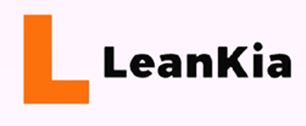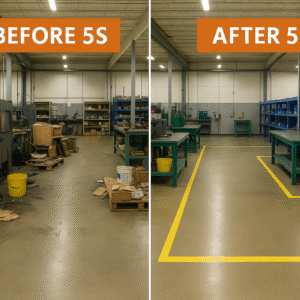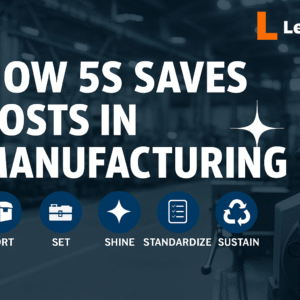In today’s fast-paced and highly regulated business environment, organizations are constantly looking for effective ways to manage risk, improve safety, and optimize operations. One of the most powerful methodologies for achieving these goals is the 5S system, a workplace organization tool originally developed in Japan. While 5S is widely known for boosting efficiency and productivity, its role in risk management is often overlooked. In this blog, we’ll explore how the 5S methodology can play a pivotal role in identifying, mitigating, and managing risks, leading to safer and more efficient workplaces.
The 5S system, when implemented effectively, leads to a more organized, efficient, and safe work environment. But how does it tie into risk management?
How 5S Contributes to Risk Management
Risk management involves identifying, assessing, and mitigating risks that could affect the safety, productivity, and profitability of an organization. 5S is a proactive approach to reducing many of the risks commonly encountered in workplaces by focusing on organization, cleanliness, standardization, and discipline. Here’s how each principle of 5S can help mitigate different types of risks:
1. Sort (Seiri) – Reducing Hazardous Clutter
The first principle of 5S, Sort, focuses on eliminating unnecessary items from the workspace. This is crucial for risk management because clutter and disorganization are common sources of physical and operational hazards. Items left lying around can obstruct walkways, contribute to tripping hazards, or become fire risks. Additionally, excess tools, materials, or machinery may cause confusion, increasing the likelihood of errors, accidents, or inefficiencies.
Risk Mitigation:
- By clearing out unnecessary items, workplaces become less crowded and more organized.
- Reduces the risk of accidents such as slips, trips, and falls.
- Prevents potential fire hazards due to accumulated waste or unused equipment.
2. Set in Order (Seiton) – Enhancing Access and Reducing Operational Risks
Setting in Order involves organizing tools, equipment, and materials so they are easy to access and use. When tools and supplies are properly arranged and labeled, employees can find what they need quickly and without unnecessary movement. This reduces operational risks such as injuries from reaching for or mishandling tools, or wasting time searching for necessary equipment, which can lead to inefficiencies and errors.
Risk Mitigation:
- Improves ergonomics by ensuring tools are stored at convenient and safe heights.
- Reduces time wasted searching for tools, thus reducing stress and errors.
- Improves operational flow, minimizing the risk of accidents caused by disorganized workflows.
3. Shine (Seiso) – Preventing Equipment Failure and Maintaining Cleanliness
The Shine step focuses on keeping the workplace clean and ensuring equipment is well-maintained. Regular cleaning and maintenance help identify potential issues before they become serious problems. For example, dirty or unclean machinery can malfunction or even pose serious safety risks, such as overheating or leakage of hazardous substances. A clean environment also reduces the likelihood of contamination in industries such as food manufacturing or pharmaceuticals.
Risk Mitigation:
- Regular cleaning prevents equipment malfunction or failure due to dirt or debris buildup.
- Identifies potential safety issues with machinery, such as wear and tear, before they lead to accidents.
- Reduces the risk of contamination in sensitive environments.
4. Standardize (Seiketsu) – Consistency in Practices Reduces Errors and Variability
Standardizing processes ensures that everyone in the workplace follows the same set of procedures for tasks, cleaning, and maintenance. This reduces variability in how tasks are performed and minimizes human errors that can lead to accidents or operational failures. In high-risk industries, like manufacturing, standardization is key to ensuring safety procedures are consistently followed.
Risk Mitigation:
- Establishes clear safety protocols and procedures, ensuring they are consistently followed by all employees.
- Reduces errors due to inconsistent work practices, which can lead to safety incidents.
- Enhances communication and reduces confusion about roles, responsibilities, and expectations.
5. Sustain (Shitsuke) – Creating a Culture of Safety and Discipline
The Sustain principle focuses on maintaining the improvements achieved through 5S by creating a culture of discipline. Employees are encouraged to adhere to the 5S system daily, which ensures that safety and efficiency improvements are not only achieved but also sustained over time. This culture of continuous improvement helps reduce the likelihood of risks reappearing or safety lapses occurring due to complacency.
Risk Mitigation:
- Promotes ongoing adherence to safety practices, creating a work culture where safety is prioritized.
- Encourages employees to identify and report hazards as part of their daily routine.
- Establishes a system of accountability to ensure that safety standards are maintained.
Benefits of 5S in Risk Management
Implementing 5S as part of a company’s risk management strategy offers several key benefits:
- Reduced Workplace Accidents:
By organizing the workspace and eliminating clutter, 5S minimizes tripping hazards, falls, and other workplace accidents. Proper storage and labeling of materials also reduce the chances of accidents caused by misplaced tools or machinery. - Improved Compliance with Safety Regulations:
Many industries are subject to strict safety regulations. 5S helps ensure that workplaces meet these regulations by keeping the environment clean, organized, and compliant with safety standards. - Increased Productivity:
A more organized and efficient workplace reduces operational risks such as delays or errors that can lead to accidents or safety violations. This also results in smoother workflows and enhanced employee morale. - Enhanced Quality Control:
By minimizing clutter and focusing on standardized procedures, 5S helps improve quality control, reducing defects and errors that could result in product recalls or safety hazards. - Proactive Risk Identification:
5S encourages continuous improvement and regular checks of equipment and processes, making it easier to spot potential risks before they cause harm or financial loss.
Conclusion
The 5S methodology is more than just a tool for improving productivity and organization—it is an essential element of effective risk management. By focusing on organization, cleanliness, standardization, and discipline, 5S helps identify, mitigate, and prevent risks, creating a safer and more efficient workplace. Whether in manufacturing, healthcare, or any other industry, incorporating 5S into your risk management strategy can lead to reduced accidents, improved compliance, and better overall operational performance.

















